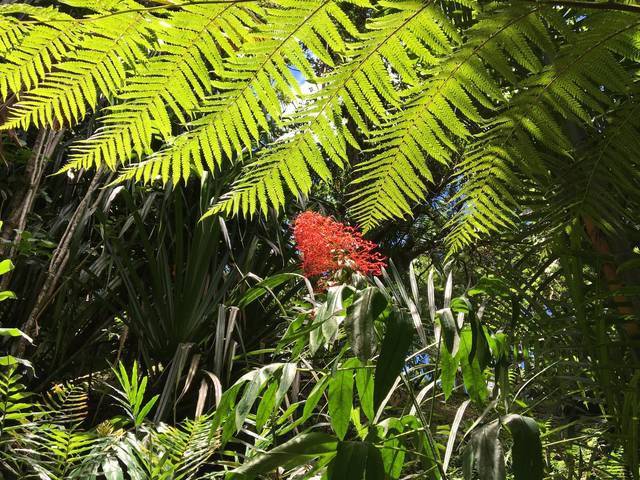Malia asks: My family has some land mauka of Kona at about 3,000 feet elevation. It has been grazed for many years but since the cattle are gone, I would like to plant some trees and reforest the land. Do you know where could I get advice and help to do this?
Malia asks: My family has some land mauka of Kona at about 3,000 feet elevation. It has been grazed for many years but since the cattle are gone, I would like to plant some trees and reforest the land. Do you know where could I get advice and help to do this?
Tropical Gardener Answer: Reforesting Hawaiian land is always a good idea, especially if you are planning to plant some of the native Hawaiian trees that covered the area at one time. Lots of information on reforestation and maintaining upland forests will be available at a presentation by Norman Bezona, a local champion of forest preservation.
His presentation called “Being Forest Friendly” is at 10 a.m. Saturday at the Kailua-Kona Public Library on Hualalai Road.
Norm and his family have done an excellent job of planting and maintaining his 75 acres in Koloko mauka for the last 40 years. At his elevation, similar to yours, he refers to the area as a cloud forest. It is cool and damp, a very favorable environment for lots of different palms and ferns including native and introduced species. Large native trees like ohia, koa, and kukui and many rare species thrive on his land.
Norman will happily inform attendees at the talk about the Hawaiian Islands Land Trust, an organization that he has worked with to put part of his land into a conservation trust. Realizing the importance of forests in the Hawaiian ecosystem, the Trust helps conserve areas in Hawaii for protection from development. HILT is a nonprofit organization that advises landowners on ways to include conservation into their plans helping to insure the land’s preservation into perpetuity.
In 2011, HILT became a statewide conservation entity by combining the existent land trusts in each county in order to serve the entire state. The county organizations had been active for more than 20 years protecting natural and cultural resources with the help of donors and volunteers. Over the years, they have been able to successfully protect many agricultural lands and ranches, wildlife habitats, coastal areas, and watersheds as well as Hawaiian cultural sites, parks and recreation areas.
At the home page of the HILT website you can learn more about the organization. At https://www.hilt.org/protected-lands/hawaii-island/ you can view more than a dozen of the protected areas here on Hawaii Island. Some of them include agricultural or forested land in West Hawaii.
Norman is a firm believer in the importance of forests to the Hawaiian ecosystem and in his presentation he will describe ways we can support local conservation efforts and become more forest friendly. He will also talk in particular about his cloud forest and describe the plants he is able to grow successfully in his microclimate.
For years, Norm and his family carved out more than 2 miles of walking paths through their land and in 1980, they began offering an opportunity for locals as well as tourists to experience a living cloud forest. You can learn more about the Kona Cloud Forest Sanctuary at www.konacloudforest.com/.
For more information about next Saturday’s presentation and events as part of the Community Seed Library series and supported by Friends of the Library in Kona (FOLK), visit https://www.folkhawaii.com.
If you cannot attend the talk, you can certainly contact the Hawaiian Islands Land Trust directly to see if they can offer you some suggestions for your land and the possibilities for conservation planning in its future.
Email plant questions to konamg@ctahr.hawaii.edu for answers by Certified Master Gardeners. Some questions will be chosen for inclusion in this column.
Diana Duff is a plant adviser, educator and consultant living in a dryland forest north of Kailua-Kona.
Gardening Events
Friday: “Hawaii Tropical Fruit Growers Monthly Meeting,” 7-9 p.m. at West Hawaii Tropical Fruit Growers office 81-6393 Mamalahoa Highway in Kealakekua. Jim West will discuss some of the 600 tropical fruit tree species he’s growing in his current home in Ecuador. Bring fruit to share. For more information contact Brian Lievens President West Hawaii Chapter at 895-8753 or greenwizard@hawaii.rr.com.
Friday-Sunday (next week): “Ka’u Coffee Festival,” annual festival celebrating award-winning Ka‘u coffee from May 19 to 28. All-day, free hoolaulea on May 27 at Pahala Community Center. For more information, visit www.kaucoffeefest.com.
Farmer Direct Markets
Wednesday: “Sunset Farmers Market,” 2 p.m. to sunset at the north makai corner of the Kmart parking lot.
Wednesday and Friday: “Hooulu Farmers Market,” 9 a.m. to 2 p.m. at Sheraton Kona Resort &Spa at Keauhou Bay
Friday: “Pure Kona Market,” 9 a.m. to 5 p.m. at Amy Greenwell Garden in Captain Cook
Saturday: “Keauhou Farmers Market,” 8 a.m. to noon at Keauhou Shopping Center
“Kamuela Farmer’s Market,” 7 a.m. to noon at Pukalani Stables
Sunday: “Pure Kona Green Market,” 9 a.m. to 2 p.m. at Amy Greenwell Garden in Captain Cook
Tuesday through Saturday: “U-Pick greens and produce,” 10a.m. to 4p.m. Tropical Edibles Nursery, Captain Cook.
Plant Advice Lines
Anytime: konamg@ctahr.hawaii.edu
Tuesdays and Thursdays: 9 a.m. to noon at UH-CES in Kainaliu, 322-4892
Mondays, Tuesdays and Fridays: 9 a.m. to noon at UH-CES at Komohana in Hilo, 981-5199 or himga@hawaii.edu

